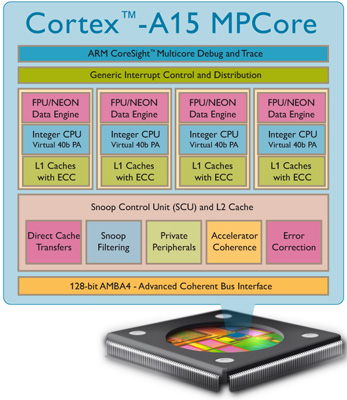ARM Aims at Intel, Cortex A15 Headed for Smartphones, Notebooks and Servers
by Anand Lal Shimpi on September 9, 2010 12:01 AM EST- Posted in
- Smartphones
- Arm
- Cortex A15
- Mobile
- SoCs

Last month TI announced it was the first to license ARM’s next-generation Eagle core. Today, ARM is announcing the official name of that core: it’s the ARM Cortex A15.
Architectural details are light, and ARM is stating that first silicon will ship in 2012 at 32/28nm. Here’s what we do know. The Cortex A15 will be a multi-core CPU, designs can have as few as a single core but most will have 2 - 4 cores depending on their target market.
The cores will all be superscalar out-of-order designs and support Long Physical Address Extensions (greater than 32-bit memory addressing). I suspect the cores will be an evolution of the Cortex A9. The Cortex A15 will support extensions to the ARMv7 instruction set to enable hardware virtualization support (among other things).
The Cortex A15 will feature private L1 caches but a shared L2 cache (similar to the A9). The L2 cache is stated to be low latency and up to 4MB in size, although smartphones will probably see smaller versions. ARM is promising FP and SIMD performance improvements, but it isn't saying anything more than that.
ARM is listing performance as 5x a Cortex A8 but we don’t have a good estimate vs. Cortex A9. Clock targets are as follows:
1) 1 - 1.5GHz single or dual-core for smartphones and mobile devices
2) 1 - 2GHz dual or quad-core for netbooks/notebooks/nettops
3) 1.5 - 2.5GHz quad-core for home and web servers
ARM is targeting more than just smartphones with the Cortex A15. This will be the architecture that ARM takes into the low end notebook and netbook market. That’s right, with the Cortex A15 ARM is going after AMD and Intel - it wants to fend off the impending x86 assault on its territory.
In addition to notebooks/netbooks based on Cortex A15, ARM will also be targeting the server market with its next architecture. As Xeon and Opteron grow more powerful, so does the need for simpler, lower power consumption servers. We’ve seen some companies attempt to address this market, but expect the floodgates to open in a couple of years as ARM officially supports it. The Cortex A15 will also enable virtualization support, specifically for the server market.
It’s too early to know anything about how well the Cortex A15 will do, but it’s clear that Atom (and maybe even Bobcat) are going to have to face a threat from below just as ARM is gearing up to face the threat from above.
Given that the first Cortex A9 designs have yet to ship it’ll be a little while before we see smartphones, tablets, notebooks and servers based on Cortex A15. Today’s announcement is simply ARM’s statement of intent. ARM doesn’t plan on staying in the smartphone market forever, it has bigger things planned.










36 Comments
View All Comments
Trisagion - Thursday, September 9, 2010 - link
"The Cortex A15 will support a new instruction set which ARM is calling ARMv7-A."The ARM v7 architecture has two 'profiles' - the ARMv7-A which is meant for regular application processors (like in smartphones) and the ARMv7-M which is for micro controllers (Cortex-M). ARMv7-A is not new. The extended address space and virtualization features are called extensions to the existing ARMv7-A profile.
Anand Lal Shimpi - Thursday, September 9, 2010 - link
Thanks for the correction!Take care,
Anand
Trisagion - Thursday, September 9, 2010 - link
Sorry, I forgot to mention the third profile ARMv7-R for real time applications. Just FYI.JarredWalton - Thursday, September 9, 2010 - link
Wonder if this will get the netbooks something more compelling than Atom with regards to HD video, plus better battery life? Looking at smartphones that last 8 hours on a 5.5Wh battery, that's about an order of magnitude better than Atom and still ~1/3 the performance. So give us the performance boost to beat Atom by 2X, and we'd still be looking at 14 hours battery life! One can only hope....Trisagion - Thursday, September 9, 2010 - link
I still think this new processor will not be faster than an Atom, but I also think people will be more put off with the lack of Windows support rather than the performance gap, which depending on the number of cores etc, I'm guessing, will not be that great.B3an - Saturday, September 11, 2010 - link
From everything i know about these new ARM CPU's they will be faster than Atom. They need to be anyway, Atoms performance is pathetic at best.No x86 will be a problem for servers but smartphones dont use x86, and many netbooks dont use windows, same with tablets. You'll probably get Chrome OS or Android 3.0 on these ARM A15 netbooks and tablets.
mino - Thursday, September 9, 2010 - link
Um, in 2012 there is 28nm Ontario shrink and next-gen Atom.While I would not dismiss 2012 ARM as competition for today's (2yr old!) Atom, 2012 is a completely different game ...
If everything goes well, they shall work well in iPads and thin clients and embedded devices of the time.
Outside that - no x86 = Windows = no PC market inroads. Unfortunately.
mino - Thursday, September 9, 2010 - link
= no Windows =LtGoonRush - Thursday, September 9, 2010 - link
nVidia's Tegra 5 processors based on these cores should support execution of x86 code using Transmeta's Code Morphing technology that they licensed. Whether this will actually happen or if it will support running Windows on a Tegra 5-based netbook/notebook remains to be seen.Klinky1984 - Thursday, September 9, 2010 - link
Well there's a quick way to kill performance & battery life.